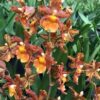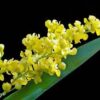# Exploring Wild Oncidium Orchids: A Journey into Nature

Oncidium orchids, commonly known as “Dancing Lady Orchids,” are a stunningly diverse group of plants known for their intricate and vibrant flowers. While many enthusiasts cultivate hybrids in their homes, the wild species of Oncidium offer a unique glimpse into the natural beauty and ecological significance of these orchids. In this article, we will delve into the various species of wild Oncidium orchids, their habitats, unique characteristics, and their importance in ecosystems. Additionally, we will discuss conservation efforts and how we can appreciate these beautiful plants in their natural settings.
## Table of Contents
1. **Introduction to Oncidium Orchids**
– 1.1 Overview of the Oncidium Genus
– 1.2 Distinctive Features of Oncidium Orchids
2. **Natural Habitats of Wild Oncidium Orchids**
– 2.1 Geographic Distribution
– 2.2 Preferred Environments
3. **Notable Wild Oncidium Species**
– 3.1 Oncidium sphacelatum
– 3.2 Oncidium varicosum
– 3.3 Oncidium altissimum
– 3.4 Oncidium leucochilum
– 3.5 Oncidium papilio
4. **Ecological Significance of Wild Oncidium Orchids**
– 4.1 Role in Biodiversity
– 4.2 Relationships with Pollinators
5. **Conservation Challenges for Wild Oncidium Orchids**
– 5.1 Habitat Loss
– 5.2 Over-collection and Illegal Trade
– 5.3 Climate Change
6. **Conservation Efforts and Initiatives**
– 6.1 Protected Areas and Reserves
– 6.2 Community Involvement in Conservation
7. **How to Appreciate Wild Oncidium Orchids**
– 7.1 Responsible Wildlife Observation
– 7.2 Supporting Conservation Efforts
8. **Conclusion**
## 1. Introduction to Oncidium Orchids
### 1.1 Overview of the Oncidium Genus
The Oncidium genus is part of the Orchidaceae family and includes over 200 species and countless hybrids. Native primarily to tropical and subtropical regions of Central and South America, Oncidium orchids are well-known for their charming and diverse flowers. The name “Oncidium” derives from the Greek word “onkos,” meaning “swelling,” which refers to the unique shape of the lip of the flower.
### 1.2 Distinctive Features of Oncidium Orchids
Oncidium orchids are recognized by their small to medium-sized blooms, often characterized by vibrant colors, intricate patterns, and unique shapes that resemble dancing figures. These orchids typically have a pseudobulb structure that stores water and nutrients, enabling them to thrive in their natural habitats. Their flowers can vary greatly in color, ranging from yellow and brown to red and white, making them highly attractive to both gardeners and wildlife enthusiasts.
## 2. Natural Habitats of Wild Oncidium Orchids
### 2.1 Geographic Distribution
Wild Oncidium orchids are primarily found in the tropical regions of Central and South America, with a few species located in the southern parts of North America. Countries such as Brazil, Colombia, Ecuador, and Venezuela are particularly rich in Oncidium diversity, hosting numerous species in their lush forests and ecosystems.
### 2.2 Preferred Environments
Oncidium orchids thrive in a variety of natural environments, including:
– **Tropical Rainforests**: These orchids are often found growing on tree trunks and branches, where they can access filtered sunlight and moisture.
– **Cloud Forests**: In higher elevations, Oncidium species can be found in misty environments that provide high humidity levels.
– **Dry Forests**: Some Oncidium species have adapted to survive in drier conditions, growing in areas with seasonal rainfall.
## 3. Notable Wild Oncidium Species
### 3.1 Oncidium sphacelatum
Oncidium sphacelatum is a popular species known for its striking yellow flowers with dark markings. It is commonly found in lowland tropical forests, often growing as an epiphyte. The flowers bloom in clusters, creating a stunning display that attracts pollinators.
### 3.2 Oncidium varicosum
This species is characterized by its beautiful, pendulous spikes of bright yellow flowers with deep maroon spots. Oncidium varicosum typically grows in warm, humid environments, making it a favorite among orchid enthusiasts for its unique appearance.
### 3.3 Oncidium altissimum
Oncidium altissimum is notable for its tall flower spikes, which can reach impressive heights. The flowers are predominantly yellow, with a delightful fragrance that attracts various pollinators. This species thrives in rainforests and can often be found at higher elevations.
### 3.4 Oncidium leucochilum
Recognized for its striking white flowers, Oncidium leucochilum is a stunning species that can be found in humid, shaded areas of tropical forests. The white petals contrast beautifully with the vibrant yellow lip, making it a sought-after species for collectors.
### 3.5 Oncidium papilio
Commonly referred to as the “Butterfly Orchid,” Oncidium papilio is famous for its unique flower shape, resembling a butterfly in flight. The flowers are usually yellow with brown markings, and they are known for their delightful fragrance. This species is often found in humid environments, where it can thrive as an epiphyte.
## 4. Ecological Significance of Wild Oncidium Orchids
### 4.1 Role in Biodiversity
Wild Oncidium orchids contribute significantly to biodiversity in their native ecosystems. They provide habitat and food sources for various species, including insects, birds, and mammals. The presence of these orchids can indicate the health of their environment, as they are sensitive to changes in temperature, humidity, and soil conditions.
### 4.2 Relationships with Pollinators
Oncidium orchids have evolved intricate relationships with specific pollinators, such as bees, butterflies, and hummingbirds. Their unique flower shapes and colors attract these pollinators, which in turn help in the reproduction of the orchids. This mutualistic relationship is crucial for the survival of both the plants and the pollinators, highlighting the importance of preserving their habitats.
## 5. Conservation Challenges for Wild Oncidium Orchids
### 5.1 Habitat Loss
One of the primary threats to wild Oncidium orchids is habitat loss due to deforestation and land development. As forests are cleared for agriculture, urbanization, and logging, the natural environments that these orchids depend on are rapidly disappearing.
### 5.2 Over-collection and Illegal Trade
The demand for orchids in the horticultural market has led to over-collection of wild species. Illegal trade of Oncidium orchids poses a significant risk to their populations, as collectors often harvest these plants without regard for sustainability or conservation.
### 5.3 Climate Change
Climate change impacts the delicate ecosystems where Oncidium orchids thrive. Changes in temperature and rainfall patterns can disrupt their growth cycles and reproductive success, potentially leading to declines in wild populations.
## 6. Conservation Efforts and Initiatives
### 6.1 Protected Areas and Reserves
Many countries are recognizing the need to protect wild orchids and their habitats. National parks and reserves are being established to safeguard critical ecosystems where Oncidium species can thrive. These protected areas provide a refuge for these plants and contribute to biodiversity conservation.
### 6.2 Community Involvement in Conservation
Community-based conservation initiatives are gaining traction as local communities recognize the value of preserving their natural heritage. Education and awareness programs are being implemented to teach people about the importance of orchids and their roles in the ecosystem. Local involvement in conservation efforts fosters a sense of stewardship and responsibility toward protecting these beautiful plants.
## 7. How to Appreciate Wild Oncidium Orchids
### 7.1 Responsible Wildlife Observation
For those interested in observing wild Oncidium orchids, responsible wildlife observation is key. Respect natural habitats by not disturbing plants or wildlife and following designated trails when hiking in orchid-rich areas. Documenting and sharing sightings can contribute to local conservation efforts.
### 7.2 Supporting Conservation Efforts
You can support conservation efforts by donating to organizations that focus on orchid preservation, participating in local conservation projects, or advocating for policies that protect natural habitats. Every effort counts in the fight against habitat loss and climate change.
## 8. Conclusion
Wild Oncidium orchids are remarkable plants that contribute to the beauty and biodiversity of their natural habitats. By exploring their unique species, understanding their ecological significance, and recognizing the challenges they face, we can foster a deeper appreciation for these extraordinary orchids. As we work towards their conservation, we ensure that future generations can experience the wonder of wild Oncidium orchids in their natural environments. Whether through responsible observation, supporting conservation efforts, or educating others about these incredible plants, we all play a role in preserving the legacy of Oncidium orchids in the wild.

